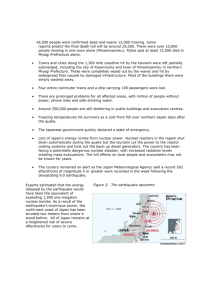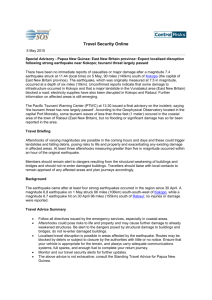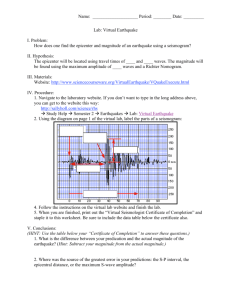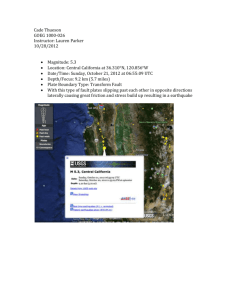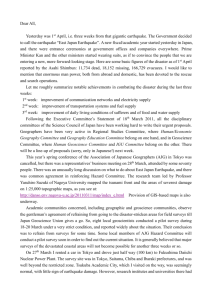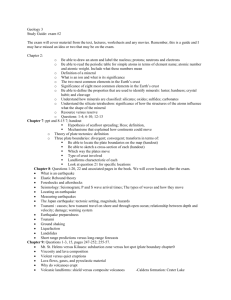Magnitude 8.9 NEAR THE EAST COAST OF HONSHU, JAPAN
advertisement
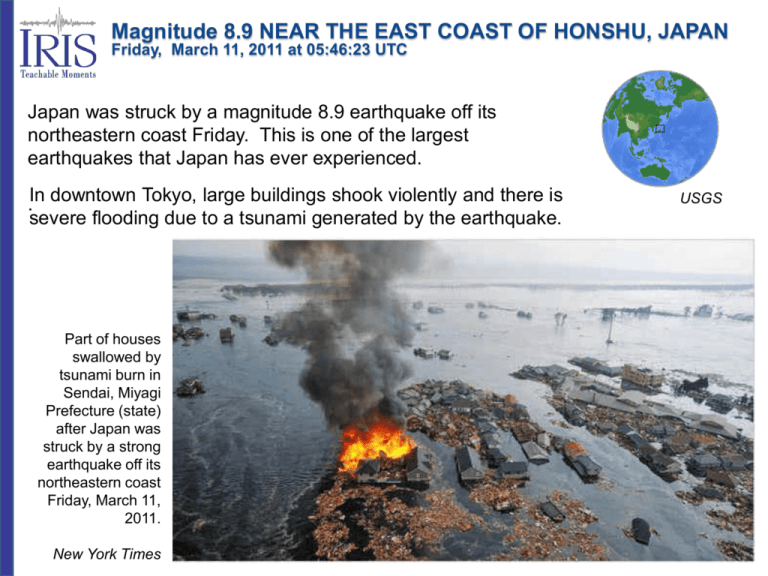
Magnitude 8.9 NEAR THE EAST COAST OF HONSHU, JAPAN Friday, March 11, 2011 at 05:46:23 UTC Japan was struck by a magnitude 8.9 earthquake off its northeastern coast Friday. This is one of the largest earthquakes that Japan has ever experienced. .In downtown Tokyo, large buildings shook violently and there is severe flooding due to a tsunami generated by the earthquake. Part of houses swallowed by tsunami burn in Sendai, Miyagi Prefecture (state) after Japan was struck by a strong earthquake off its northeastern coast Friday, March 11, 2011. New York Times USGS Magnitude 8.9 NEAR THE EAST COAST OF HONSHU, JAPAN Friday, March 11, 2011 at 05:46:23 UTC Tsunami waves swept away houses and cars in northern Japan and pushed ships aground. The tsunami waves traveled far inland, the wave of debris racing across the farmland, carrying boats and houses with it. The tsunami, seen crashing into homes in Natori, Miyagi prefecture. AP Houses were washed away by tsunami in Sendai, Miyagi Prefecture in eastern Japan, after Japan was struck by a magnitude 8.9 earthquake off the northeastern coast. New York Times Magnitude 8.9 NEAR THE EAST COAST OF HONSHU, JAPAN Friday, March 11, 2011 at 05:46:23 UTC CNN reported “The quake rattled buildings and toppled cars off bridges and into waters underneath. Waves of debris flowed like lava across farmland, pushing boats, houses and trailers toward highways.” Additionally, a number of fires broke out including one at an oil refinery which at this time, is burning out of control. Giant fireballs rise from a burning oil refinery in Ichihara, Chiba Prefecture (state) after Japan was struck by a strong earthquake off its northeastern coast Friday, March 11, 2011. Los Angeles Times Magnitude 8.9 NEAR THE EAST COAST OF HONSHU, JAPAN Friday, March 11, 2011 at 05:46:23 UTC This earthquake occurred 130 km (80 miles) east of Sendai, Honshu, Japan and 373 km (231 miles) northeast of Tokyo, Japan. Images courtesy of the US Geological Survey Magnitude 8.9 NEAR THE EAST COAST OF HONSHU, JAPAN Friday, March 11, 2011 at 05:46:23 UTC Globally, this is the 5th largest earthquake since 1900. Great (M > 8) Earthquakes Since 1900 9.6 Chile 1960 9.4 Alaska 1964 9.2 Magnitude Sumatra 2004 9 Japan 2011 8.8 Chile 2010 8.6 8.4 8.2 8 7.8 1900 1920 1940 1960 Year 1980 2000 2020 Magnitude 8.9 NEAR THE EAST COAST OF HONSHU, JAPAN Friday, March 11, 2011 at 05:46:23 UTC Shaking intensity scales were developed to standardize the measurements and ease comparison of different earthquakes. The Modified-Mercalli Intensity scale is a twelve-stage scale, numbered from I to XII. The lower numbers represent imperceptible shaking levels, XII represents total destruction. A value of IV indicates a level of shaking that is felt by most people. Modified Mercalli Intensity Perceived Shaking Extreme Violent Severe Very Strong Strong Moderate Light Weak Not Felt Image courtesy of the US Geological Survey USGS Estimated shaking Intensity from M 8.9 Earthquake Magnitude 8.9 NEAR THE EAST COAST OF HONSHU, JAPAN Friday, March 11, 2011 at 05:46:23 UTC The USGS PAGER map shows the population exposed to different Modified Mercalli Intensity (MMI) levels. MMI describes the severity of an earthquake in terms of its effect on humans and structures and is a rough measure of the amount of shaking at a given location. Overall, the population in this region resides in structures that are resistant to earthquake shaking. The color coded contour lines outline regions of MMI intensity. The total population exposure to a given MMI value is obtained by summing the population between the contour lines. The estimated population exposure to each MMI Intensity is shown in the table below. Image courtesy of the US Geological Survey USGS PAGER Population Exposed to Earthquake Shaking Magnitude 8.9 NEAR THE EAST COAST OF HONSHU, JAPAN Friday, March 11, 2011 at 05:46:23 UTC Peak ground acceleration is a measure of violence of earthquake ground shaking and an important input parameter for earthquake engineering. The force we are most experienced with is the force of gravity, which causes us to have weight. The peak ground acceleration contours on the map are labeled in percent (%) of g, the acceleration due to gravity. Map showing measured Peak Ground Accelerations across Japan measured in percent g (gravity). Image courtesy of the US Geological Survey Magnitude 8.9 NEAR THE EAST COAST OF HONSHU, JAPAN Friday, March 11, 2011 at 05:46:23 UTC Earthquake and Historical Seismicity This earthquake (gold star), plotted with regional seismicity since 1990, occurred at approximately the same location as the March 9, 2011 M 7.2 earthquake. In a cluster, the earthquake with the largest magnitude is called the main shock; anything before it is a foreshock and anything after it is an aftershock. A main shock will be redefined as a foreshock if a subsequent event has a larger magnitude. This earthquake redefines the M 7.2 earthquake as a foreshock, with this event replacing it as the main shock. Image courtesy of the US Geological Survey Magnitude 8.9 NEAR THE EAST COAST OF HONSHU, JAPAN Friday, March 11, 2011 at 05:46:23 UTC Aftershocks Aftershock sequences follow predictable patterns as a group, although the individual earthquakes are themselves not predictable. The graph below shows how the number of aftershocks and the magnitude of aftershocks decay with increasing time since the main shock. The number of aftershocks also decreases with distance from the main shock. Aftershocks usually occur geographically near the main shock. The stress on the main shock's fault changes drastically during the main shock and that fault produces most of the aftershocks. Sometimes the change in stress caused by the main shock is great enough to trigger aftershocks on other, nearby faults. Image and text courtesy of the US Geological Survey Magnitude 8.9 NEAR THE EAST COAST OF HONSHU, JAPAN Friday, March 11, 2011 at 05:46:23 UTC This earthquake was preceded by a series of large foreshocks over the previous two days, beginning on March 9th with an M 7.2 event approximately 40 km from the March 11 earthquake, and continuing with 3 earthquakes greater than M 6 on the same day. The M8.9 earthquake has been followed by frequent large aftershocks, which can do damage on their own especially to buildings that were compromised in the main shock.” The M8.9 main shock (red star) is plotted with 14 aftershocks larger than magnitude 6.0. This includes a magnitude 7.1. Magnitude 8.9 NEAR THE EAST COAST OF HONSHU, JAPAN Friday, March 11, 2011 at 05:46:23 UTC This earthquake was the result of thrust faulting along or near the convergent plate boundary where the Pacific Plate subducts beneath Japan. This map also shows the rate and direction of motion of the Pacific Plate with respect to the Eurasian Plate near the Japan Trench. The rate of convergence at this plate boundary is about 83 mm/yr (8 cm/year). This is a fairly high convergence rate and this subduction zone is very seismically active. Eurasian Plate Japan Trench Pacific Plate Magnitude 8.9 NEAR THE EAST COAST OF HONSHU, JAPAN Friday, March 11, 2011 at 05:46:23 UTC At the latitude of this earthquake, the Pacific plate moves approximately westwards with respect to the Eurasian plate at a velocity of 83 mm/yr. The Pacific plate thrusts underneath Japan at the Japan Trench, and dips to the west beneath Eurasia. The location, depth, and focal mechanism of the March 11 earthquake are consistent with the event having occurred as thrust faulting associated with subduction along this plate boundary. USGS Centroid Moment Tensor Solution Shaded areas show quadrants of the focal sphere in which the P-wave first-motions are away from the source, and unshaded areas show quadrants in which the P-wave firstmotions are toward the source. The dots represent the axis of maximum compressional strain (in black, called the "P-axis") and the axis of maximum extensional strain (in white, called the "T-axis") resulting from the earthquake. Magnitude 8.9 NEAR THE EAST COAST OF HONSHU, JAPAN Friday, March 11, 2011 at 05:46:23 UTC Locations of NOAA’s National Data Buoy Center (NDBC) DART stations comprising the operational network. Tsunami monitoring systems have been strategically deployed near regions with a history of tsunami generation, to ensure measurement of the waves as they propagate towards coastal communities and to acquire data critical to real-time forecasts. Magnitude 8.9 NEAR THE EAST COAST OF HONSHU, JAPAN Friday, March 11, 2011 at 05:46:23 UTC Shallow great earthquakes in subduction zones often cause tsunamis when they offset the ocean floor. This offset generates tsunami waves. This earthquake did produce a tsunami, which was measured on a nearby buoy and triggered the warning system. The water column height change that triggered the system. Flash animation of how the DART system detects ocean waves Magnitude 8.9 NEAR THE EAST COAST OF HONSHU, JAPAN Friday, March 11, 2011 at 05:46:23 UTC The DART II® system consists of a seafloor bottom pressure recording (BPR) system capable of detecting tsunamis as small as 1 cm, and a moored surface buoy for real-time communications. DART II has two-way communications between the BPR and the Tsunami Warning Center (TWC) using the Iridium commercial satellite communications system. The two-way communications allow the TWCs to set stations in event mode in anticipation of possible tsunamis or retrieve the high-resolution (15-s intervals) data in one-hour blocks for detailed analysis. DART II systems transmit standard mode data, containing twenty-four estimated sea-level height observations at 15-minute intervals, once very six hours. NOAA Magnitude 8.9 NEAR THE EAST COAST OF HONSHU, JAPAN Friday, March 11, 2011 at 05:46:23 UTC This tsunami propagation forecast model shows the forecast maximum tsunami wave height (in cm). Ocean floor bathymetry affects the wave height because a tsunami moves the seawater all the way to the floor of the ocean. This led to a Pacific wide tsunami warning being issued. Magnitude 8.9 NEAR THE EAST COAST OF HONSHU, JAPAN Friday, March 11, 2011 at 05:46:23 UTC Projected travel times for the arrival of the tsunami waves across the Pacific. Nearby the earthquake there are only minutes to evacuate. However, in many other regions there is advance warning. A tsunami map shows projected travel times for the Pacific Ocean. This map indicates forecasted times only, not that a wave traveling those distances has actually been observed.. NOAA

